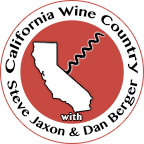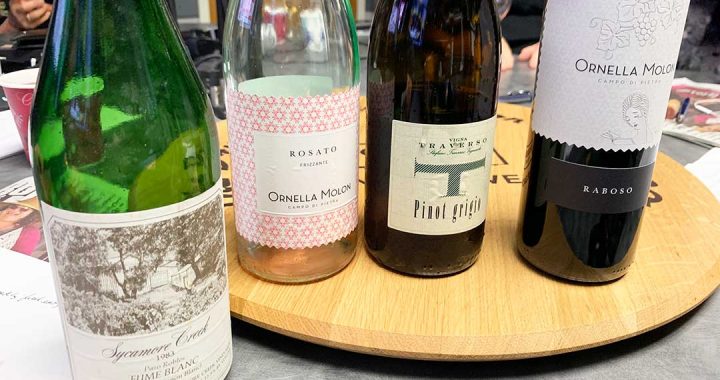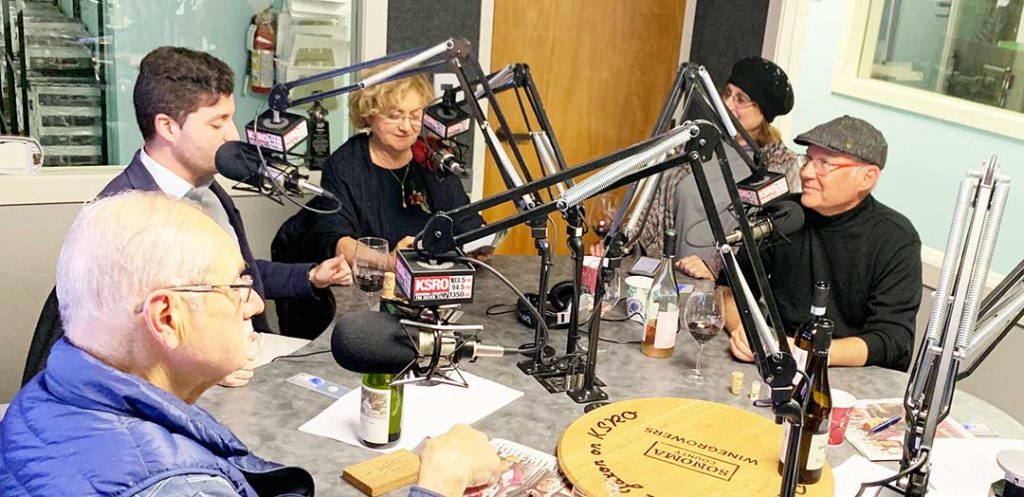Podcast: Play in new window | Download (Duration: 42:09 — 19.4MB) | Embed
Subscribe: Apple Podcasts | RSS | More
We continue our series on women in the wine business, where we repeat podcast episodes while we don’t have new shows, due to issues arising from the Coronavirus. This episode featuring Italian winemaker Ornella Molon was originally broadcast on May 15, 2019, almost exactly one year ago.
Ornella Molon and Loris Traverso are in with Don Chigazola today on California Wine Country with Steve Jaxon and Dan Berger. Ornella Molon and her son Loris Traverso produce wine at their family’s two wineries, in the Veneto and Friuli regions of Italy. (In a couple of places, Ornella speaks in Italian, then her son translates for her. For anyone interested in her comments in Italian, there is a transcript and translation of her words, at the bottom of this page.)
Loris explains how his parents started in the wine business in 1982. Neither his father nor his mother had a background in wine. When his grandparents gave them a vineyard when they were married in 1977, they started making wine, first for friends and then professionally. When they registered the winery as a business in 1982 at the Chamber of Commerce in Treviso, it was the first time that a woman was put in charge of the company. People were skeptical of a woman in that role, but Ornella has had great succeess and in Loris’ words, “My mom would say that she had to prove herself at the winery.” She says it was hard but it was good because she had to prove herself to everyone. Her advice to other women in the wine business is, “keep fighting, show who you are, and show everyone your value.”
They are located in Treviso, a small city about 30 minutes from the city of Venice, in the Veneto region. Their villa and cantina, centuries ago, was the summer home of the Doge of Venice (English pronunciation is “dodj” and the Italian pronunciation is “DO-jeh”).
Don Chigazola tells how he got started as a wine importer. He is retired from the tech industry and he has followed his passion for Italian wine since founding Chigazola Merchants with his son. They travel the back roads of Italy and look for small family producers who are making excellent wine. Don also speaks Italian, which is important for his business.
Don and Dan agree that it is the small producers in Italy make these very fine wines. The larger producers in Italy are the ones who supply American supermarkets and those wines are nothing like these. Dan Berger explains that American supermarkets do not stock the kinds of wine that Don Chigazola imports. Don’s wines are in some local restaurants (he mentions Riviera and Ca’ Bianca) and at Oliver’s Markets. They are also at Bottle Barn.
They taste a Rosato, which is Italian for Rosé. It is a 2017 and has light bubbles. This Rosato is made from Cabernet Franc, which is a very common varietal in northeastern Italy. They make it as a red and a rosato. It is very dry and has very thin bubbles. Dan explains that you can taste the wine with the bubbles, then wait a while and the bubbles will go away, the wine is equally interesting but different.
The next wine is their newest release, a 2017 Pinot Grigio from their second label and cantina, Vigna Traverso in Friuli (in northeast Italy next to Slovenia). Steve asks Dan how this Italian Pinot Grigio differs from the ones from California. Dan says that here, we start with much riper grapes, so we get more florality and are more alluring in the aroma department. However they have less acidity. Then there are two Italian styles, mass production and also cold climate small production. This is one of those cold climate wines that would go well with food.
Loris tells about the vineyard. Ponca is the name of the kind of soil, called marn in English. They do not use any barrels here. They only use French oak for their red wines. Loris also tells that his mother and father each have a vineyard and winery. His father found and acquired a winery in the Friuli region in the early 1990s. They produce about 8000 cases per year, which is a fairly small production.
The next wine is a Raboso which is a unique variety indiginous to the Veneto in the area around the Piave River, where their cantina and villa are located. This is a 2012 vintage. It has strong acidity and it would go well with anything in a red sauce. It is hard to compare this to any kind of American wine. It was known as the travelling wine. Before refrigeration, the wine would last in the casks on long voyages.
Ornella describes Raboso as a varietal unique to the Piave region of the Veneto, which carries with it the history of the territory and its people. It is a very late ripening grape and is the last to be harvested every year. It makes wines of great distinction.
Loris adds that Raboso never was affected by philloxera, the plants are very strong. The skins are thick and crunchy, so they are the last ones that mature and they are the last of the harvest.
In the final minutes, Dan opens this week’s very old bottle. It’s a 1983 Sycamore Creek Fumé Blanc. It was lost in the back of his cellar, and it is quite past its prime. It was just opened and it will be good for another ten minutes. The wine “is on its way out the door.” Dan said these old bottles would be hit and miss and this is a miss.
Here are separate audio tracks with transcripts and close translations, of the two portions where Ornella Molon spoke in Italian:
@ 4:12, Ornella introduces herself and her son Loris.
OK! Buona sera a tutti, io sono Ornella Molon. Vi porto i saluti dall’Italia e vi mando un grande bacio. Adesso Loris vi racconterà un po’ la storia nostra della nostra azienda e dei nostri vini.
OK! Good afternoon to everyone, I’m Ornella Molon. I bring you greetings from Italy and I send you a big kiss. Now Loris will tell you a bit about our history, our company and our wines.
@ 35:59, Loris asks Ornella to describes the Raboso varietal, which she does (at 36:06).
Loris: Vuoi parlare del Raboso, il fatto della produzione, in Italiano, cosa pensi del vino, e poi io tradurrò?
Would you like to talk about Raboso, about the production, in Italian, what you think of the wine, and then I will translate?
Ornella: Certamente, con molto piacere. Il Raboso è un vitigno antichissimo, rappresenta proprio la terra e la gente del Piave. È una vite che è molto robusta, che è passata attraverso le guerre, attraverso le siccità, e racconta un po’ la storia del nostro territorio. È l’ultima uva che noi raccogliamo, a fine ottobre, primi novembre. Ha una buccia veramente molto resistente e ci da la possibilità di fare, con questa uva, di fare un vino di grande interesse, di grande forza e di grande durata nel tempo e negli anni. Voi vedete che anche questo è un 2012 (due mila dodici). Ha un colore ancora vivacissimo, un colore molto vivo. Sembra un’uva, un vino vendemmiato ieri.“
Certainly, with great pleasure. Raboso is a very old varietal and it represents the land and the people of the Piave. It is a very robust grape and has survived wars, droughts and carries with it the history of the land. It is the last grape that is harvested, at the end of October and the beginning of November. It has a very thick skin. With this grape we can make very interesting wine, with strong character, that can endure many years in the cellar. You can see that this is a 2012 and its color is still very lively, very vivid. It tastes like a wine that was made just yesterday.


